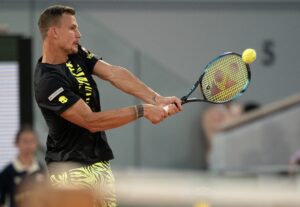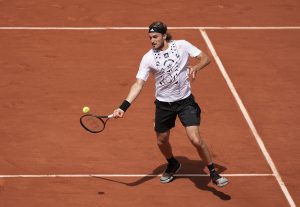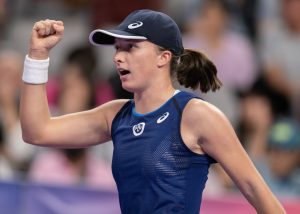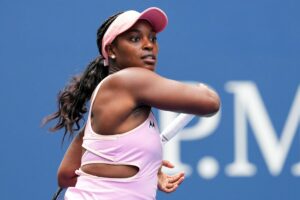Damon and Naomi are a fairly successful dream-pop/folk duo who emerged from the ashes of their parent (and far superior) band, Galaxie 500. By contrast, Naomi Osaka and Novak Djokovic could be the duo who dominate tennis for years to come – if not quite 500, then certainly quite a few.
Four times a year, after every Major, the tennis world resets and recalibrates, assessing where it now is. After the Covid-affected first Major of the year, the Australian Open, the temptation is to regard the winners of the Women’s and Men’s Singles, Naomi Osaka and Novak Djokovic, as having emerged from the tournament as the undisputed Queen and King of tennis. Indeed, as the era of “The Big Three” – Djokovic, Rafael Nadal and Roger Federer – finally seems to be coming to an end (Federer did not even make it to Melbourne and Nadal lost in the quarterfinal to Stefanos Tsitsipas), it is just possible that we are entering the time of “The Two Ns” – Naomi and Novak.
If so, it will be the first time for a while – roughly since Serena Williams began her long, slow and ultimately sad decline (although no-one knew it at the time) after winning the 2017 Australian Open – that there has been a really dominant World No.1 in both the men’s and women’s game, so dominant that there is no need to use their surnames to identify them.
Of course the 2021 Australian Open was the fourth Major that Osaka has won, but this victory seemed qualitatively different to those that had gone before. Having won two Majors in a row early in her career (the 2018 US Open and the 2019 Australian Open), Osaka split with her coach and then entered what for her was a relative wilderness period, as she did not win another Major until 18 months later, at the 2020 US Open.
And even after that win completed a hat-trick of Major titles, Osaka chose not to compete at the French Open a month later, perhaps wisely deciding that attempting to win two Majors within a month on completely different surfaces was beyond her. Now, however, having won her fourth Major at Melbourne last weekend, Osaka really looks ready to dominate women’s tennis in a way that she has never really shown before.
Her decimation of Serena Williams in the Australian Open semifinal (in effect, doing to Williams what Williams has done to so many others) proved conclusively that she is finally ready to leave her childhood heroine in her wake. Equally, the two women who might prove her greatest rivals in the years to come, Bianca Andreescu and Iga Swiatek, endured relatively miserable Australian Opens, and perhaps even more importantly are a few years younger than Osaka, who is now 23.
It’s not so much the age of Osaka that matters as her new-found maturity. Over the last year, she really seems to have found herself, both as a player and even more importantly as a person. Her close and intimate involvement with the Black Lives Matter campaign, wearing a face-mask bearing the image of a different black person who had died because of police brutality for each round of the US Open, has marked her out as potentially the most important on and off-court campaigner in tennis since the great Billie Jean King in the 1970s.
Equally, she has appeared far calmer and self-assured during matches, notably when a succession of double-faults threatened to derail her against Serena late in their match. Having been broken, she completed the “boomerang break” (breaking back immediately), appropriately enough in the land of the boomerang.
Of course, Major obstacles lie ahead, literally. She has never won or even done particularly well on either the clay of Roland Garros or the grass of Wimbledon. However, in the wake of her second Australian Open title, which confirmed her as the queen of hard courts, she openly acknowledged her need to become an all-surface player. She will have to adjust to the far slower surface in Paris and the quicker grass of Wimbledon, although the courts in Melbourne were so fast this year that they may just remain the fastest courts at any Major this year.
There will be no such problem of acclimatisation, as it were, for Djokovic at either Roland Garros or Wimbledon, having triumphed at both of them before – five times in fact at Wimbledon, if only once in Paris. However, at the French Open he will face the challenge that he himself has described as being not just the toughest in tennis but the toughest in all of sport, namely defeating Nadal on the famous red clay of Paris.
Nadal will be smarting after letting slip a two-set lead over Tsitsipas in Melbourne, so he will be even more determined to make it a remarkable 14th French Open title in May, which would finally take him past the 20-Major mark that he and Federer currently share.
The last time that Nadal conquered Paris, of course, which was only a few months ago after the inevitable readjustments to the tennis calendar in 2020, he absolutely demolished Djokovic in the final, thus achieving some kind of revenge for the similar mauling that Djokovic had inflicted on him in the 2019 Australian Open final. However, Djokovic, being the supreme, single-minded and occasionally surly competitor that he is, will surely not allow himself to be humiliated in the French Open final twice in succession.
So, if he does make it through to the second Sunday against Nadal, for what would effectively be a “decider” between the two men of their recent Major final “series” of matches, the likelihood is that he will be far better better prepared than he was in October to give the Spaniard a run for his money. Incidentally, tennis itself could use a Major Men’s final that lives up to the billing, after two successive duds: the Djokovic no-show in Paris; and Daniil Medvedev’s vanishing act in Melbourne. To have a third successive utterly one-sided final would do the sport’s image no good at all.
If Djokovic can somehow defeat Nadal in Paris (and at the moment that is the biggest if in tennis history), then the way would be (relatively) clear for him to make a serious attempt to win the Grand Slam. That is, the actual – i.e. calendar – Grand Slam of winning all four Majors in the same year, rather than winning them in succession but over two calendar years, as he managed to do in 2016 when he won the so-called “Nole Slam”.
If he could do that, becoming only the third man in tennis history to completely dominate one 12-month period at the Majors (after Don Budge and Rod Laver), then his own case for being considered the greatest of “The Big Three” would be given a huge boost. Indeed, if he were to win all four Majors this year, then he, rather than Nadal or Federer, would make it “21 in ‘21”.
For the moment, that is obviously a long way off. However, if Djokovic can somehow complete a clean sweep of this year’s Majors, and if Osaka can win either the French Open or Wimbledon to consolidate her position at the top of women’s tennis, then 2021 can legitimately be said to be “The Time Of The Two Ns”, when one great champion (Novak) finally pulled clear of his two greatest rivals and another (Naomi) showed that she was the Alpha Female of her own era.
Main photo:
Embed from Getty Images






